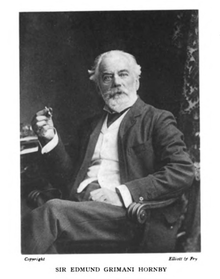Edmund Grimani Hornby

Sir Edmund Hornby (29 May 1825 – 17 November 1896) was a leading Jewish-Italian British judge, with family interests in diamond-rich Antwerp. He was the founder and Chief Judge of both the British Supreme Consular Court at Constantinople and British Supreme Court for China and Japan.[1]
(Hornby had a nephew, Edmund Hornby Grimani, who also had a career in China with the Chinese Maritime Customs. The two should not be confused).
Early life
Hornby was born in 1825, in St. Swithin, London on 29 May 1925, to Thomas and Francesca Hornby. His father was from Yorkshire and his mother was the daughter of William Grimani of the Grimani family of Venice.
He was called to the bar of Middle Temple in 1848 and practiced briefly in London. In 1853, he was appointed a commissioner of Mixed British and American Commission settling outstanding individual claims between Britain and the USA. Following this, he was appointed as a commissioner of the Turkish Loan lent by Britain to Turkey during the Crimean War with Russia.
Judicial Career
While in Turkey, Hornby sat as a consular assessor in the British consular courts. Hornby was asked by the Foreign Office to write a report on the exercise of extraterritorial judicial powers in Turkey by consuls who had no legal training or background. Hornby recommended setting up a court with dedicated staff to handle judicial work. This was accepted and on 27 August 1857, at the age of 32, Hornby was appointed Judge of the British Supreme Consular Court at Constantinople. He was knighted five years later in 1862 at the early age of 37.
In 1865, Hornby was appointed Chief Judge of the newly established British Supreme Court for China and Japan in Shanghai. Charles Wycliffe Goodwin was appointed Assistant Judge. The court had jurisdiction over British subjects in China and Japan. Hornby served as Chief Judge for 11 years before retiring, at the age of 51 in 1876. He was succeeded by Englishman George French, the former Chief Justice of Sierra Leone.
Marriages
Hornby married three times. His first wife was Emelia Macerone (sometimes spelt Maceroni), daughter of Count Maceroni, aide-de-camp of Captain Joachim Murat. She died suddenly in Dieppe, France in 1866 when Hornby was in Shanghai.[3] In 1868, he married Mary Hudson, the daughter of Mr Thomas Hudson of Hull. She died in Shanghai on 13 December 1873.[4] In 1875, he married the much younger Miss Emily Roberts, who at the time was 20, in Shanghai. She survived Hornby, dying in 1909.[5]
Post Retirement
After retirement, Hornby moved to Devon. He maintained an interest in international law and helped to work out a scheme that led to the establishment of the Hague Tribunal. He also wrote a pamphlet for the Peace Preservation Society, advocating the establishment in Switzerland of a school or faculty of international law to be kept up jointly by the Powers.
Death
Sir Edmund died in his sleep on 17 November 1896 after a long mountain climb in Rapallo, Italy, at the age of 71. He was buried in Rapallo.[6]
References
- ↑ Unless otherwise noted, bibliographical information is from Hornby's obituary in the Times, November 20, 1896, p9
- ↑ "Images of Formosa in the Illustrated London News, 1859-1890.". reed.edu. Archived from the original on 2015-12-16. Retrieved 2015-12-16.
- ↑ London and China Telegraph, October 15, 1866, p536
- ↑ North China Herald, 18 December 1873, p525
- ↑ New York Times, August 3, 1909
- ↑ Hornby, An Autobiography, Introduction by Constance Drummond (nee Hornby)
Further Reading
- Sir Edmund Hornby, An Autobiography
- Clark, Douglas (2015). Gunboat Justice: British and American Law Courts in China and Japan (1842-1943). Hong Kong: Earnshaw Books., Vol. 1: ISBN 978-988-82730-8-9; Vol. 2: ISBN 978-988-82730-9-6; Vol. 3: ISBN 978-988-82731-9-5
